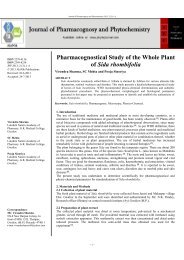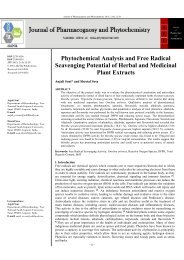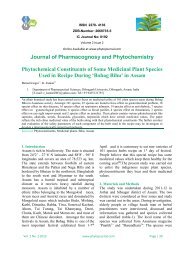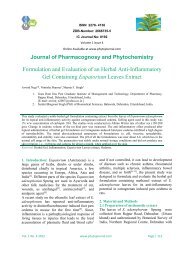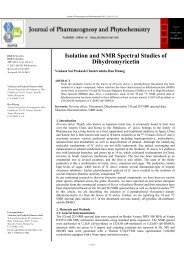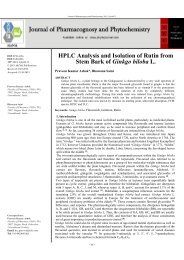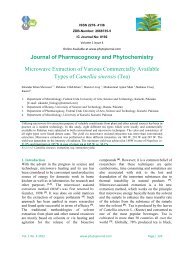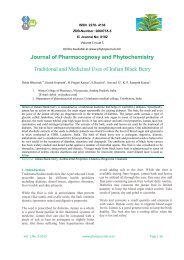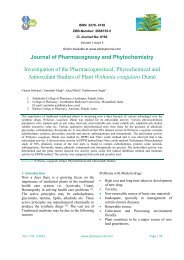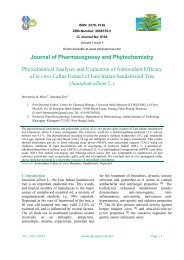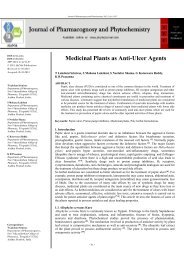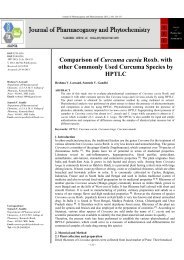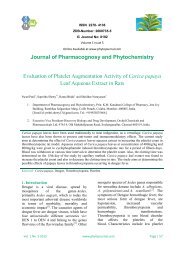In-Vitro Anthelmintic Activity of Luffa cylindrica Leaves - Journal of ...
In-Vitro Anthelmintic Activity of Luffa cylindrica Leaves - Journal of ...
In-Vitro Anthelmintic Activity of Luffa cylindrica Leaves - Journal of ...
Create successful ePaper yourself
Turn your PDF publications into a flip-book with our unique Google optimized e-Paper software.
ISSN 2278- 4136ZDB-Number: 2668735-5IC <strong>Journal</strong> No: 8192Online Available at www.phytojournal.com<strong>Journal</strong> <strong>of</strong> Pharmacognosy and Phytochemistry<strong>In</strong>-<strong>Vitro</strong> <strong>Anthelmintic</strong> <strong>Activity</strong> <strong>of</strong> <strong>Luffa</strong> <strong>cylindrica</strong> <strong>Leaves</strong>in <strong>In</strong>dian Adult EarthwormSangh Partap 1* , Saurabh Kumar 1 , Amit Kumar 1 , Neeraj K. Sharma 1 , K. K. Jha 11. College <strong>of</strong> Pharmacy, Teerthankar Mahaveer University, Moradabad, Uttar Pradesh, <strong>In</strong>dia.[E-mail: sangh.partap@gmail.com]Different extracts <strong>of</strong> L. <strong>cylindrica</strong> were taken for anthelmintic activity against <strong>In</strong>dian earthworm Pheritimaposthuma. Two concentrations (50 and 100 mg/ml) <strong>of</strong> various extracts were tested and results were expressed interms <strong>of</strong> time for paralysis and time for death <strong>of</strong> worms. Albendazole (20 mg/ml) was used as reference standard andcarboxy methyl cellulose (0.5%) as a control group. Dose dependent activity was observed in the plant extracts butmethanolic extract exhibited more activity as compared to others. The anthelmintic activity <strong>of</strong> <strong>Luffa</strong> <strong>cylindrica</strong>leaves extract has therefore been demonstrated for the first time.Keyword: <strong>Anthelmintic</strong>, <strong>Luffa</strong> <strong>cylindrica</strong>, Pheretima posthuma, Methanolic extract.1. <strong>In</strong>troductionHelminthes infections, repeatedly entitledhelminthiasis are among the most pervasiveinfection and a foremost degenerative diseasedistressing a large proportion <strong>of</strong> world’spopulation. <strong>In</strong> developing countries, they pose alarge threat to public health and contribute to theprevalence <strong>of</strong> malnutrition, anemia, eosinophilliaand pneumonia [1] . The helminths parasitesmainly subsist in human body in intestinal tract,but they are also found in tissue, as their larvaemigrate towards them [2] . Most diseases caused byhelminths are <strong>of</strong> a chronic, debilitating nature;they probably cause more morbidity and greatereconomic and social deprivation among humansand animals than any single group <strong>of</strong> parasites.Chemical control <strong>of</strong> helminthes coupled withimproved management has been the importantworm control strategy throughout the world.However, development <strong>of</strong> resistance inhelminthes [3,4] against conventional anthelminticsis a foremost problem in treatment <strong>of</strong> helminthesdiseases [5,6] . Henceforth it is important to look foralternative strategies against gastrointestinalnematodes, which have led to the proposal <strong>of</strong>screening medicinal plants for their anthelminticactivity.<strong>Luffa</strong> [L.<strong>cylindrica</strong>(L.) Roem syn L. aegyptiacaMill] commonly called sponge gourd, lo<strong>of</strong>a,vegetable sponge, bath sponge or dish clothgourd, is a member <strong>of</strong> cucurbitaceous family. Theplant is widely distributed throughout <strong>In</strong>dia. Itsfruit is used in the traditional medicine as ananthelmentic, carminative, laxative, depurative,emollient, expectorant, and diuretic andlactagogue and are useful in fever, syphilis,tumours, bronchitis, splenopathy and leprosy [7] .It is used as a vegetable either prepared likesquash or eaten raw like cucumbers [8,9] . Its seedshave been used in the treatment <strong>of</strong> asthma,sinusitis and fever [10] . The seed oil is reported toVol. 1 No. 2 2012 www.phytojournal.com Page | 27
Sangh Partapbe used for skin infections in the form <strong>of</strong> tincture.The fruit used in the treatment <strong>of</strong> ascites, jaundiceand billiary and intestinal colitis and also inenlarged spleen and liver. The plant is reputed tohave anti tubercular and antiseptic properties. Theextract <strong>of</strong> leaves has been used in snake- bites.Keeping in mind such astounding propertiesexhibited by the plant, the present study wasintended to investigate anthelmintic activity <strong>of</strong>methanolic and aqueous extract <strong>of</strong> L.<strong>cylindrica</strong>(MELC & AELC) leaves in <strong>In</strong>dian earthworm.2. Material and Method2.1 Plant materialThe leaves <strong>of</strong> L.<strong>cylindrica</strong> were collected in themonth <strong>of</strong> July locally from Pakbara village,District Moradabad <strong>of</strong> Uttar Pradesh, <strong>In</strong>dia andwere authentified by Dr. Beena Kumari,Taxonomist, Hindu College, Moradabad (<strong>In</strong>dia)as L.<strong>cylindrica</strong> (Cucurbitaceae) leaves. A voucherspecimen has been kept in the herbarium(HC.MBD/HAP/BK/2010/5/168) <strong>of</strong> theDepartment <strong>of</strong> Botany, Hindu college,Moradabad (<strong>In</strong>dia).2.2 Experimental worms:All the experiments were carried out in <strong>In</strong>dianadult earthworms (Pheretima posthuma) due toits anatomical resemblance with the intestinalroundworm parasites <strong>of</strong> human beings. Theywere collected from moist soil and washed withwater to remove all fecal matters.2.3 Preparation <strong>of</strong> Extracts:The leaves <strong>of</strong> <strong>Luffa</strong> <strong>cylindrica</strong> were dried undershade and crushed in an electric blender to formcoarse powder and subjected to Soxhletextraction (Continuous hot extraction) by usingmethanol and water as solvent. The extracts wereconcentrated by rotary evaporator and used fortesting anthelmintic activity. Preliminaryphytochemical screening was carried out to assessthe presence <strong>of</strong> phytoconstituents in the extract.2.4 Administration <strong>of</strong> Albendazole:Albendazole (20 mg/ml) was prepared by using0.5% w/v <strong>of</strong> CMC as a suspending agent asadministered as per method <strong>of</strong> extract.2.5 Administration <strong>of</strong> extract:The suspension <strong>of</strong> Methanolic and aqueousextract <strong>of</strong> leaves <strong>of</strong> luffa <strong>cylindrica</strong> <strong>of</strong> differentconcentration (50,100mg/ml) were prepared byusing 0.5% w/v <strong>of</strong> CMC as a suspending agentand final volume was made up to 10 ml forrespective concentration. Albendazole was usedas standard. Groups <strong>of</strong> approximately equal sizeworms consisting <strong>of</strong> two earthworms individuallyin each group were released into in each 10 ml <strong>of</strong>desired concentration <strong>of</strong> drug and extracts in thepetridish.2.6 Experimental Design:The anthelmintic activity was performedaccording to the method [11] . On adult <strong>In</strong>dian earthworm Pheretima posthuma as it has anatomicaland physiological resemblance with the intestinalround worm parasites <strong>of</strong> human beings.Pheretima posthuma was placed in petridishcontaining two different concentrations (50&100mg/ml) <strong>of</strong> methanolic & aqueous extract <strong>of</strong>leaves <strong>of</strong> luffa <strong>cylindrica</strong>. Each petridish wasplaced with 2 worms and observed for paralysisor death. Mean time for paralysis was noted whenno movement <strong>of</strong> any sort could be observed,except when the worm was shaken vigorously;the time death <strong>of</strong> worm (min) was recorded afterascertaining that worms neither moved whenshaken nor when given external stimuli. The testresults were compared with Reference compoundAlbendazole (20 mg/ml) treated samples.Vol. 1 No. 2 2012 www.phytojournal.com Page | 28
Sangh PartapTime in Minute12010080604020028.7158.90104.3105.289.0386.6663.2554.2244.945.55ParalysisDeathFig 1: <strong>Anthelmintic</strong> activity <strong>of</strong> luffa <strong>cylindrica</strong> leaves on Pheretima posthumaanthelmintic activity <strong>of</strong> methanol extracts couldbe due to the constituents present.The present study suggested that the methanolextract was more effective than the other extracts,even though all the extract were endowed withanthelmintic property. The activity wasconcentration dependent <strong>of</strong> the different extracts.The activity <strong>of</strong> the extracts was found to beinversely proportional to the time taken forparalyse / death <strong>of</strong> the earth worms.4. ConclusionThe results <strong>of</strong> the present study clearly indicatedthat the crude methanol extract <strong>of</strong> <strong>Luffa</strong><strong>cylindrica</strong> did produce anthelmintic activityagainst <strong>In</strong>dian earthworm Pheretima posthuma.The plant possesses significant anthelminticactivity at 100 mg/ml concentration measured bytime taken for paralyse / death <strong>of</strong> the earthworms. The current investigation leads toconclusion that the leaves <strong>of</strong> L.<strong>cylindrica</strong> havepotent anthelmintic activity when compared withthe conventionally used drug. The results did not,however, exclude the possibility that doses <strong>of</strong> theextract with lower anthelmintic activity in thisstudy might be efficacious against other species<strong>of</strong> helminths. Further studies using in vivo modelsand to isolate active constituents from extract arerequired to carry out and established theeffectiveness and pharmacological rational for theuse <strong>of</strong> L.<strong>cylindrica</strong> as an anthelmintic drug.5. Reference1. Bundy DA. Immunoepidemiology <strong>of</strong> intestinalhelminthic infection: The global burden <strong>of</strong>intestinal nematode disease. Trans Royal Soc TropMed Hyg 1994; 8: 259-61.2. Tripathi, K.P. “Essentials <strong>of</strong> meditionalpharmacology”; 5th Edituin. Jaypee BrothersMedical Publishers (P) LTD., New Delhi, 2003; p.759.3. Coles G.C. Nematode control practices andanthelmintic resistance on British sheep farms.Vet. Rec. 1997; 141:91-93.,4. Geert S. and Dorny P. <strong>Anthelmintic</strong> resistance inhelminthes <strong>of</strong> animals <strong>of</strong> man in the tropics.Bulletin-des-Seances, Academic-Royaledes-Sciencesd. DutreMer. 1995; 3:401-423.5. Tagbota S., Townson S. Adv Parasitol, 2001;50:199-205.;6. Sondhi S.M., Shahu R., Magan Archana. <strong>In</strong>dianDrugs, 1994;31(7): 317-320.7. Prakash Yoganandam G , Ilango K, kumar sunil andElumalai A. <strong>In</strong>-vitro antioxidant activity <strong>of</strong>L.<strong>cylindrica</strong> seeds oil, <strong>Journal</strong> <strong>of</strong> Global PharmaTechnology. 2010; 2(3): 93-97.8. Yang, Y., X. Ma, W. Wu and P. Guo, 1999. Biologicalcharacters <strong>of</strong> the different varieties for <strong>Luffa</strong><strong>cylindrica</strong>. Zhong Yao Cai, 22: 165–167;Vol. 1 No. 2 2012 www.phytojournal.com Page | 30
Sangh Partap9. Oboh, I.O. and E.O. Aluyor, 2009. <strong>Luffa</strong> <strong>cylindrica</strong>anemerging cash crop. African J. Agric. Res., 4:684–688.10. Nagao T, Lanaka R, Iwase Y, Hanazone H, Okabe H.Studies on the constituents <strong>of</strong> <strong>Luffa</strong> acutangulaRoxb. Clin. Pharm. Bull. 1991; 39:599-606.11. T Ghosh; TK Maity; A Bose; GK Dash. <strong>In</strong>dian .J.natProduct, 2009, 16-19.Vol. 1 No. 2 2012 www.phytojournal.com Page | 31



